Wakefield and District Light Railways
Yorkshire (West Riding) Electric Tramways
History
The genesis of the tramway systems in and around Wakefield and Castleford is a complicated story, but one which would eventually conclude with everything (tramways and powers of extension) consolidated in the hands of a single concern, the Yorkshire (West Riding) Electric Tramways Company.
Powers to build a tramway in the neighbourhood of Wakefield were obtained in 1901 by a group of local businessmen, following which the Wakefield and District Light Railways Company was formally incorporated (on the 13th September 1901) to raise the capital, construct the authorised lines and operate the system. The W&DLRCo quickly negotiated a through-running agreement with Leeds Corporation Tramways (signed on the 24th November 1901), and then went on to acquire powers held by an earlier aspirant (the Electric Tramways Construction and Maintenance Company), as well as further powers of its own for extensions (granted on the 19th August 1902). However, in late 1902, and before construction had begun, the W&DLRCo was itself sold to a rather shadowy concern — the Ito Syndicate Limited — which appears to have been a speculative venture specifically set up to acquire and consolidate all the tramway powers around Wakefield and Castleford, with the express intention of selling them on at a profit.
Around the same time that the Ito syndicate acquired the W&DLRCo, it also bought powers (granted in 1901 and 1902) from another concern — the United Kingdom Tramway, Light Railway and Electrical Syndicate Limited —for tramways to the east of Wakefield, centred on Castleford. Its goal now achieved, the Ito syndicate lost no time in securing a very healthy profit for itself, selling its collection of powers to another group of investors on the 27th November 1902. The new owners quickly set up a new company on the 25th April 1903 — the Yorkshire Electric Tramways Construction Syndicate Ltd — to build the tramways it held powers for (circa 38 miles authorised, with 55 miles in total under consideration). By this time, the W&DLR was already under construction, contracts having already been let by the W&DLRCo, which though owned by the YETCS, continued to exist as a separate legal entity until 1911.
The W&DLR, which was a standard-gauge, overhead electric tramway, opened in large part on the 15th August 1904, the remainder (the Rothwell branch), opening around four months later in the second week of December. The tramway system took the form of a staggered cross, the main line running from Sandal in the south, through Wakefield and Rothwell Haigh, to meet the Leeds Corporation Tramway network at Thwaite Gate in the north, with a branch running southeastwards from Rothwell Haigh to Rothwell. The second line ran from Agbrigg (to the southeast of Wakefield) to join the main Sandal-Wakefield line on Barnsley Rd, which it then followed over the River Calder before turning westwards at the Bull Ring, through Norbury and South Ossett to Ossett, where it would eventually be joined to the tracks of the municipally owned Dewsbury, Ossett and Soothill Nether Tramways (opened on the 12th November 1908). Although relations with Leeds Corporation were good, Y(WR)ETCo cars running through to Leeds city centre and LCT cars running through to Rothwell (both from the 1st June 1905), numerous approaches to the councils that owned the DO&SNT, either to lease the tramway or to reach an agreement for through running, all failed. Instead, the councils leased operation of their short, 3.14-mile tramway to the contractor, the National Electric Construction Company Limited, an opportunity to deliver a better public service, more efficiently, thereby going begging.
The W&DLR was destined to last just 9 months as an independent entity, before being subsumed into the newly formed Yorkshire (West Riding) Electric Tramways Company, which had been registered on the 4th April 1905 to take over the tramway assets of the YETCS. The latter concern was in fact just the latest in a long line of promotors and speculators who had played a part in the building of the West Riding tramways, but which then sold its assets on at a profit, all of which resulted in the Y(WR)ETCo being significantly over-capitalised; this was to have fairly serious consequences for the company, as it could not realistically hope to service the accumulated debt, pay dividends and invest in new lines at the same time.
The Y(WR)ETCo's financial difficulties soon led to a significant delay in the building of the Castleford system, the contractor stopping work for many months due to not having been paid, the tramway — which like the W&DLR was standard-gauge, overhead electric — finally opening to the public on the 29th October 1906. The system essentially comprised one long main line, built on the single line with passing loop principle, running northwestwards from Pontefract through Glass Houghton to Castleford, and from there southwestwards through Whitwood Common to Normanton.
Several attempts were made to join the two systems and to extend them, but all came to nothing, some due to vigorous opposition from railway companies and local authorities, and others due to the cost of construction, the latter being a particular problem given the company's lack of capital, though this did not stop it from wasting a significant amount of money over the years continually extending powers which it then failed to use. Other than minor extensions, both systems therefore remained essentially as built, the W&DLR being much the larger (and more profitable) at 16.95 miles, with the Castleford lines adding a further 7.65 miles to give a total route mileage for the Y(WR)ET of 24.6 miles.
The company's relationship with Pontefract and Wakefield councils was also less than harmonious, the former refusing to sell the company a 5.5 ins-wide strip of land for road widening, resulting in the cutting back of the Pontefract service to Tanshelf for nearly 9 months, and the latter taking the company through a succession of courts in a battle over the tramway's rateable value, all of which the council lost, including the last one, an appeal to the House of Lords.
Although passenger loadings were healthy, the company, needing to service its debt and pay debenture holders, could not see its way to paying a dividend until 1912, and then only to preference share holders. The following year, the company sought to formally abandon its powers for various extensions, but ran into opposition from local councils, mollifying them by committing to introduce motorbus services in return for them dropping their objections. Plans were in fact well-advanced when the Great War intervened, ultimately delaying the introduction of company motorbuses by eight years. The Great War also brought its own challenges, the company losing men (and their skills) to the armed services, which together with restrictions on the availability of spares etc., led to an ever-increasing backlog in maintenance. On the plus side, passenger loadings increased significantly, reaching a maximum in 1920, which in turn improved the company's financial position. This allowed the company to respond to a depot fire in 1917, which destroyed eight of the company's trams, by renting (then buying outright) eight tramcars from Leeds Corporation Tramways, and ordering eight new ones (delivered in 1920).
The first Y(WR)ETCo motorbus services were finally introduced on the 6th April 1922, partly in response to council pressure, the resulting passenger numbers (which were adequate but hardly huge) justifying the company's reluctance to build new tramways. The motorbus services were, however, steadily expanded, resulting — on the 16th November 1923 — in the registration of a new subsidiary, the West Riding Automobile Company Ltd, expressly to operate them.
Competition from independent bus operators had first appeared in 1921, but by 1923/24 it had increased to such a point that the company was running its own buses against them, often wholly or in part along its own tramway routes. The situation was particularly acute on the Castleford lines, with the various local councils granting licences to all and sundry, even though they stood to lose significant income (in the form of rates) should the tramway close. If that were not enough, the company's woes were compounded by mining subsidence, which the loss-making Castleford lines suffered heavily from, the councils refusing to allow the company to move them out of the roadway and onto more resilient road-side sleeper reservations. Given that they only carried one fifth of the passenger numbers, it is perhaps no surprise that following a last plea to the councils (which fell on deaf ears) the company threw in the towel, announcing that the Castlefield system would close on the 31st October 1925, to be replaced by WRACo buses. Only now, after years of ignoring representations from the tramway company, did the councils start to worry about the loss in income the closure would bring.
Throughout this period, the Wakefield lines fared much better, the company spending money on track doubling, and even making two more unsuccessful attempts to take over the DO&SNT. By the early 1930s, however, and with track renewals in the offing, the company decided to close the tramway and switch its services to motorbuses. Tram services over the Sandall-Leeds and Rothwell-Leeds routes were withdrawn on the 31st May 1932, with the last tram of all, operating over the Ossett-Agbrigg route running on the 25th July 1932.
The Y(WR)ETCo was handicapped from the start by its debt, no dividend being paid to preference share holders until 1912, with the ordinary shareholders only receiving a dividend on three occasions in over 25 years. The tramway had, however, been well run, the company having not only delivered a valuable service to the community, but much to its credit having managed to create a thriving bus operation entirely from its own income.
Uniforms
Motormen and conductors on the W&DLR were issued with single-breasted jackets with five buttons (see link), two breast pockets (with button closures), stand-up collars and epaulettes (again with button closures); the collars probably carried a metal employee number on both sides. The peaked caps had tensioned crowns (tops) and carried a large oval cap badge comprising a garter, within which was the full system title — 'WAKEFIELD & DISTRICT LIGHT RAILWAYS' — surrounding, in the centre of the badge, the system initials: 'WD&LRY' (oddly not the correct plural). Tramcar crews were also issued with long, double-breasted greatcoats with high, fold-over collars and epaulettes (with button closures); these garments do not appear to have carried any insignia.
The Y(WR)TCo's lines, which were centred on Castlefield, opened on the 29th October 1906, staff presumably being issued with uniforms bearing Y(WR)TCo insignia from the outset. The Y(WR)TCo appears to have simply adopted the W&DLR's uniform policy — as well as much else — lock stock and barrel, limiting change to the system title, where this appeared (for example, on badges, buttons and tramcars). Motormen and conductors were therefore issued with single-breasted jackets with five buttons (see link), two breast pockets (with button closures), stand-up collars and epaulettes (again with button closures); the collars carried an employee number on both sides in individual metal numerals, almost certainly brass. The tensioned-crown peaked caps bore a large oval cap badge comprising a garter, within which was the full system title — 'YORKSHIRE (WEST RIDING) ELECTRIC TRAMWAYS. CO. LTD.' — surrounding, in the centre of the badge, the company initials: 'Y(WR)ETCoLtd'. The cap badges and buttons were probably brass initially, though a switch was made to nickel at some point. Tramcar crews were also issued with long, double-breasted greatcoats with high, fold-over collars and epaulettes (with button closures); these garments do not appear to have carried any insignia.
At some point following the take-over of the W&DLR by the Y(WR)TCo (on the 4th April 1905), a switch would have been made to uniforms bearing Y(WR)TCo insignia, though the company presumably waited until new uniforms were needed, the old insignia more than likely persisting for several years.
A new 'WEST RIDING TRAMWAYS & OMNIBUSES' device was introduced in 1924, which from then on was applied to tramcars (see below) and stationery etc; a new cap badge was also produced (see below), though only a single photo of a tramwayman wearing one is known. It is likely that they were either only issued to new employees or that the tramwaymen preferred to stick with the old badge. Uniform buttons were rather bizarrely switched to chrome shortly before the demise of the tramway, a comparatively expensive material at the time.
A small number of early photographs exist that show W&DLR motormen wearing a distinctively shaped licence, almost certainly a Wakefield municipal 'DRIVER' licence (see below); these licences do not, however, appear in photographs taken after 1904/5, strongly suggesting that they were only in use for a very short time.
Inspectors wore fairly standard tramway inspector attire, namely, single-breasted jackets without buttons (more than likely hook and eye fasteners), edged with material of a finer quality than the main garment, two breast pockets (with button closures) and stand-up collars. The latter probably bore the grade — 'Inspector' — in embroidered script-lettering, though this cannot be made out with certainty on surviving photographs. Caps were initially of the drooping-peak type, and bore the grade — 'Inspector' — in embroidered script lettering, probably on a hat band. By 1912 at the latest, and possibly much earlier, these caps had been replaced by tensioned-crown peaked caps.
In common with the vast majority of UK Tramway systems, women were employed as conductresses during the Great War (from circa November 1915 onwards) to replace men lost to the armed services. Photographs are rare, but the few that have survived show that the ladies were provided with tailored, single-breasted jackets with a breast pocket, two waist-level pockets, epaulettes and lapels; the collars bore system initials — 'W R T' — on both sides in embroidered script lettering. The jackets bore plain non-metal buttons. The only headgear known are brimless cloth bonnets, akin to modern beanies; these usually bore the standard cap badge.
Further reading
For a detailed history of these two intimately associated tramways, see 'The Tramways of Dewsbury and Wakefield' by W Pickles; Light Rail Transit Association (1980).
Images
Motormen and conductors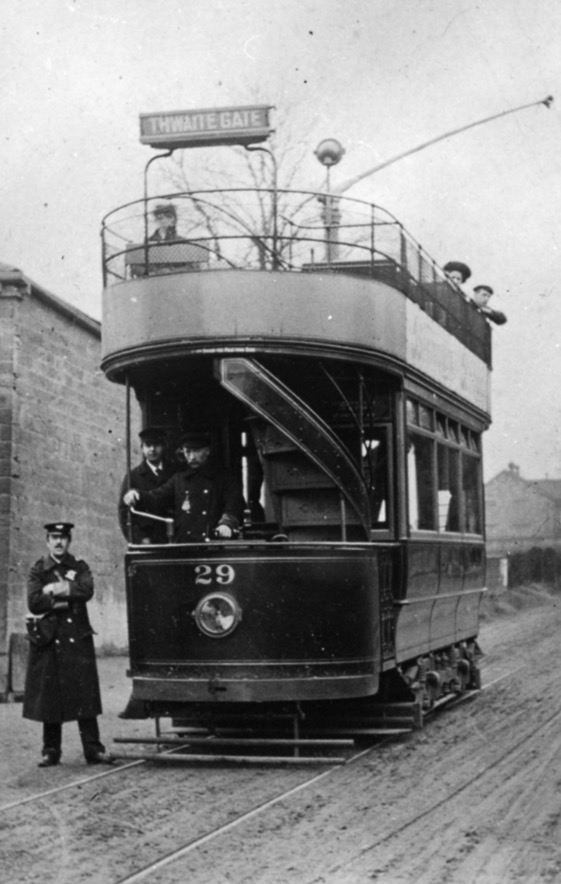
W&DLR Tramcar No 29 pictured at the Sandal terminus in 1904. Photo courtesy of the Tramways and Light Railway Society, with thanks to David Voice.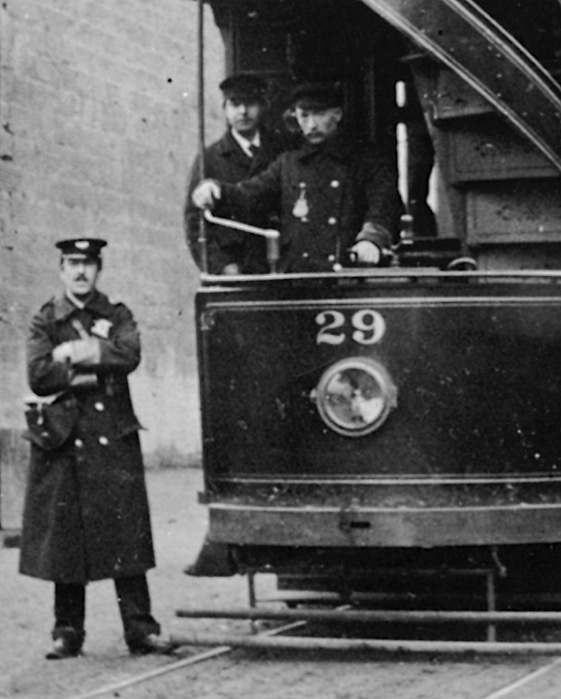
An enlargement of the above photo showing the motorman (who is undergoing instruction), a conductor and a third individual, presumably an instructor. The motorman is wearing one of the distinctively shaped Wakefield municipal 'DRIVER' licence badges, which are only evident on a very small number of photographs, suggesting that they were only in use for a very short time.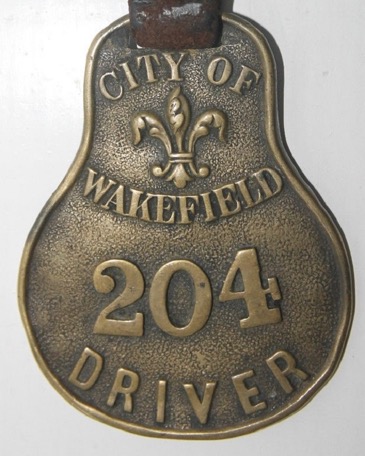
City of Wakefield 'DRIVER' licence badge — brass with leather strap — probably of the type issued to W&DLR motormen in the first two years of operation. Photo courtesy of the Stephen Howarth Collection.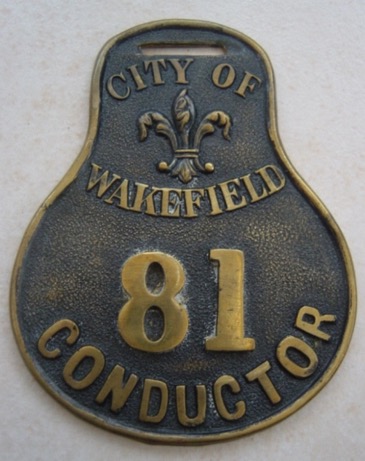
City of Wakefield 'CONDUCTOR' licence badge — brass with leather strap. Curiously, although they are many good-quality photographs of W&DLR conductors, both in the W&DLRCo and Y(WR)ETCo days, not a single one shows a licence being worn. Photo courtesy of the Stephen Howarth Collection.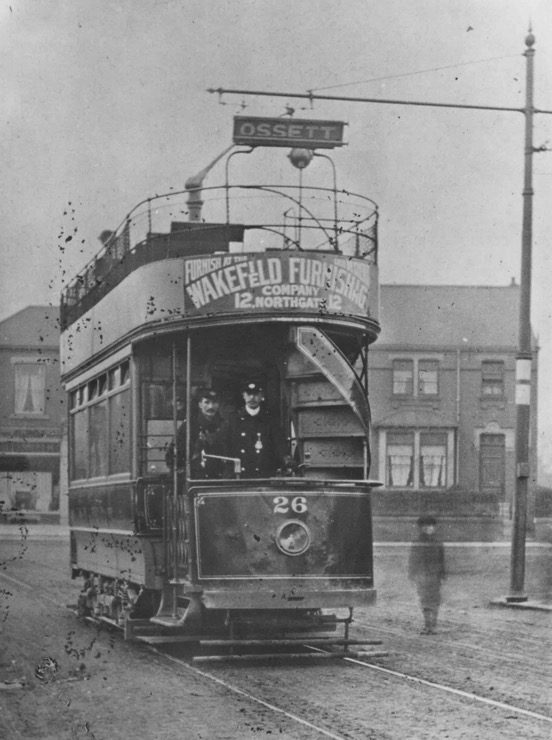
Tramcar No 26 stands at the Agbrigg terminus with Belle Vue Rd in the background — photo undated, but probably taken in late 1904 or early 1905 given that the car still has its original Hudson and Bowring lifeguard, as well as curtains and a bulkhead oil lamp (these only lasted a couple of years). Author's Collection.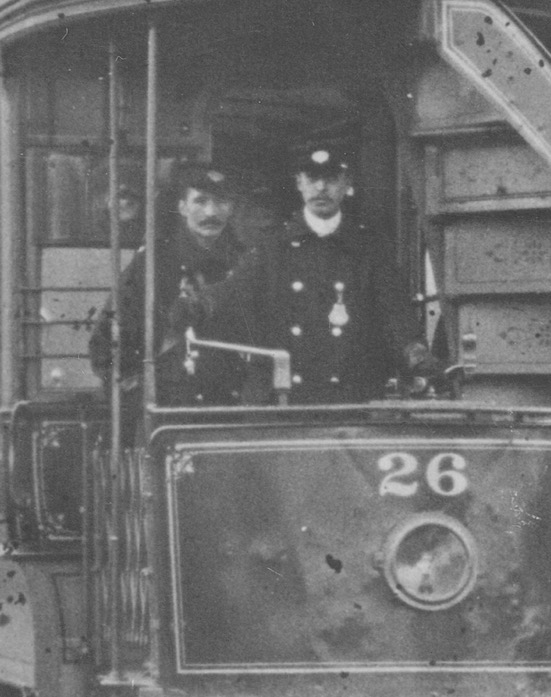
An enlargement of the above photograph showing the motorman and conductor, both men clearly wearing large oval cap badges with a prominent protrusion at the bottom. The motorman is once again wearing a Wakefield licence.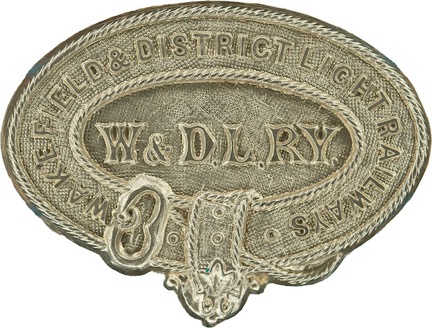
Wakefield and District Light Railways cap badge — nickel. This badge was probably worn from 1904 through to 1905/6. Author's Collection.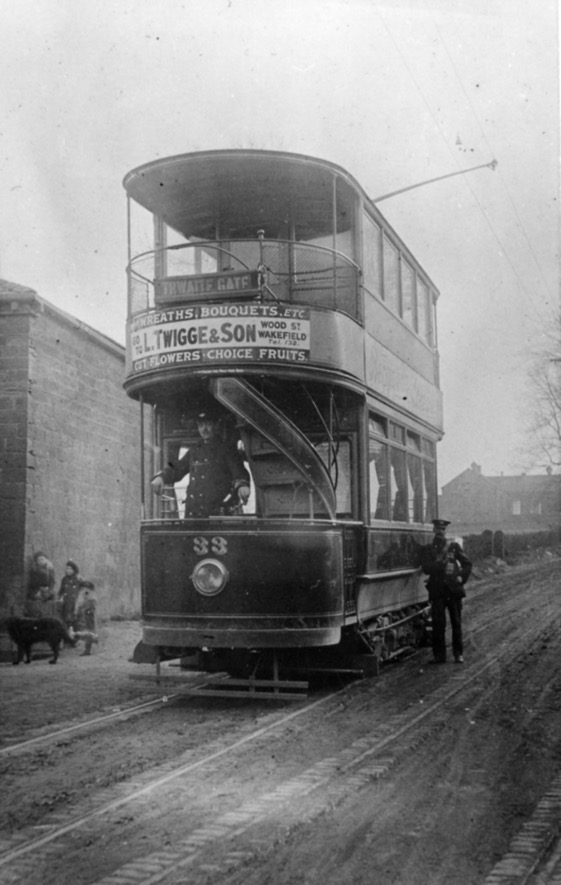
Another shot taken at the Sandal terminus, this time of a top-covered tramcar, No 33 — photo undated, but as the destination is Thwaite Gate, it was presumably taken before the commencement of through-running to Leeds (1st June 1905). This car was transferred to Castleford in time for the opening of the Y(WR)ET system on the 29th October 1906. Photo courtesy of the Tramways and Light Railway Society, with thanks to David Voice.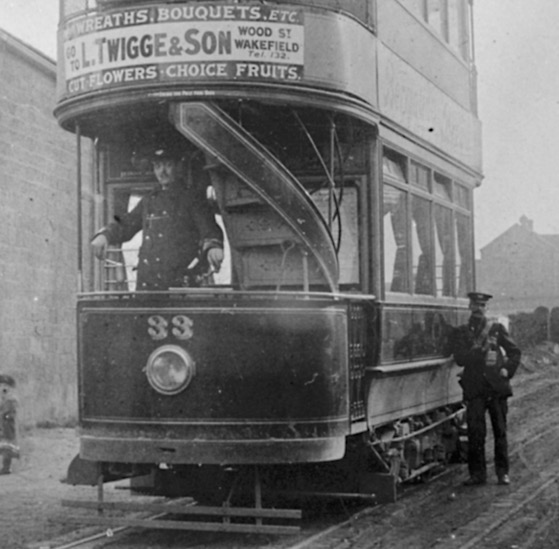
A blow-up of the above photo showing the motorman and conductor, the former in a double-breasted greatcoat (without licence) and the latter in single-breasted jacket.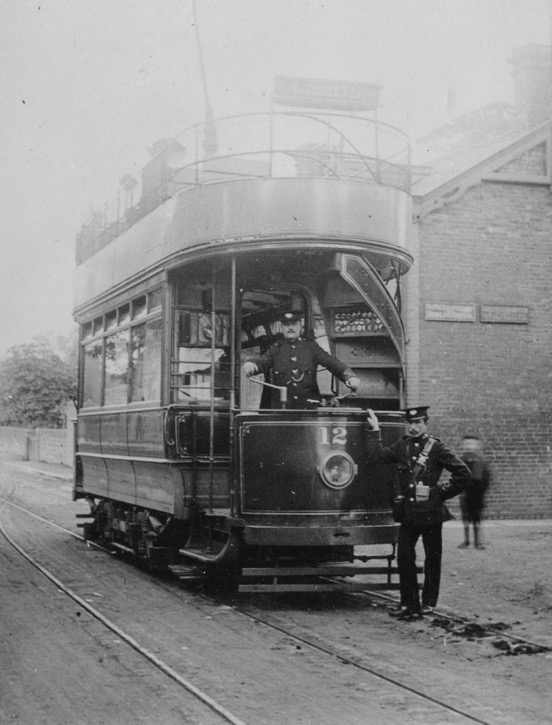
A view looking southwards at the Sandal terminus of Tramcar No 12 outside the Castle Inn — photo undated, but probably taken in the second half of 1905 or early 1906 if the Leeds destination blind is to be believed, through-running having commenced on the 1st June that year. Although the tramcar still has curtains and a bulkhead oil lamp, its original Hudson and Bowring lifeguard has been replaced by a more effective Tidswell model. Author's Collection.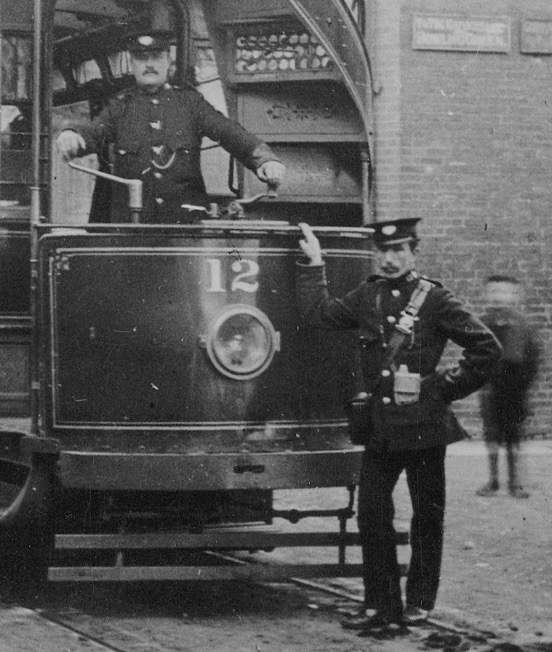
An enlargement of the above photograph showing the motorman and conductor, both of whom are wearing single-breasted jackets and tensioned-crown peaked caps with prominent oval cap badges. There is once again no sign of a Wakefield licence.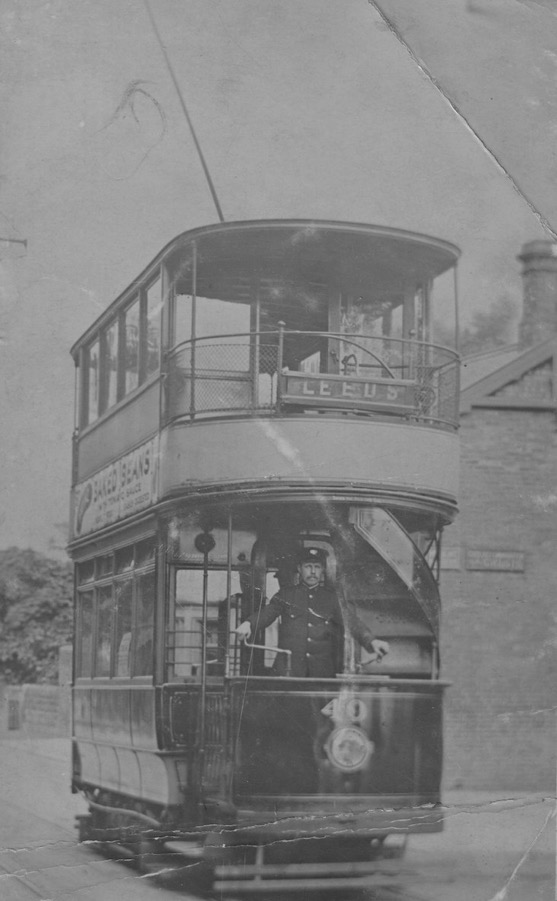
Yet another shot taken outside the Castle Inn, this time of Tramcar No 40 — photo undated, but probably taken in early 1906. Author's Collection.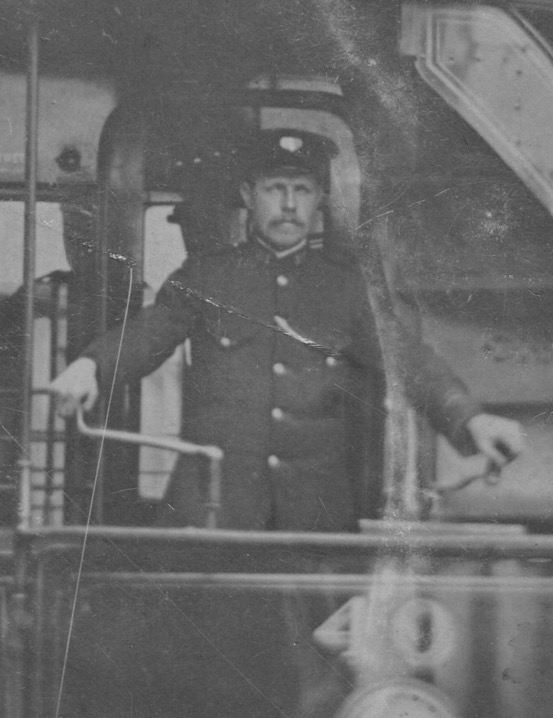
An enlargement of the above photo showing the motorman.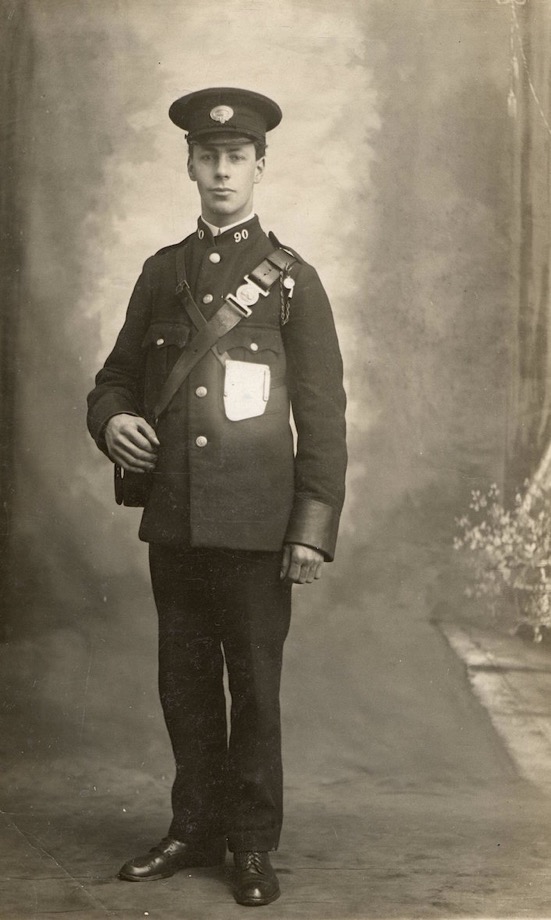
A fine studio portrait of a Y(WR)ETCo conductor (Employee No 90) — photo undated, but probably taken in the mid-Edwardian era. Author's Collection.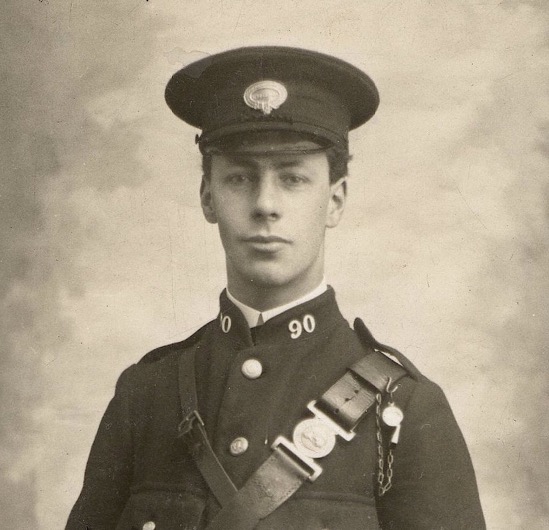
An enlargement of the above photo showing details of the uniform, magnification revealing the cap badge to be a Y(WR)ETCo issue rather than the very similar W&DLR pattern. The cash-bag buckle would appear to bear a design, probably incorporating the company's name and a device or monogram. The uniform is identical to those issued by the W&DLRCo (bar the buttons and cap badge), the Y(WR)ETCo simply adopting the former's uniform policy, presumably because it had yet to run a tram itself when it took over the W&DLR. 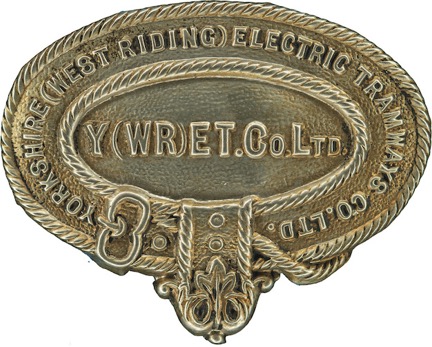
Y(WR)ETCo Ltd cap badge — nickel. This badge would been worn from 1906 right through to the end of operations (1932). Although it was superseded by a new 'WEST RIDING TRAMWAYS & OMNIBUSES' badge in 1924 (see below), photographs suggest that many tramwaymen preferred to stick with the older badges. Author's Collection.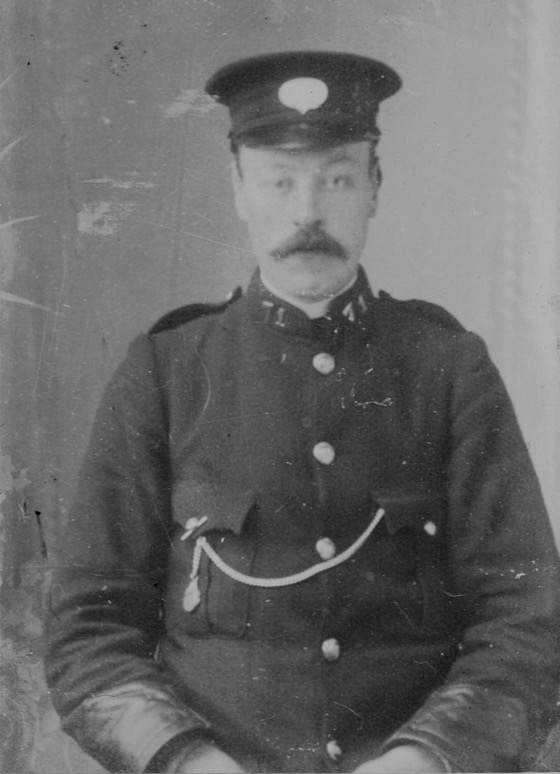
A studio portrait of a Y(WR)ETCo tramwayman, Employee No 71. Unfortunately, the type of cap badge cannot be made out. Photograph taken by S Woolston, Leeds. Author's Collection.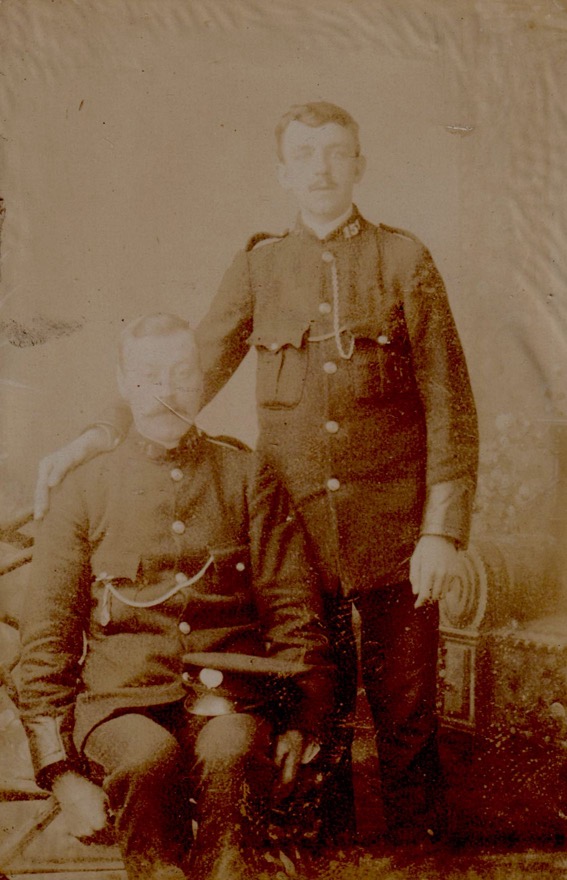
A studio portrait of a Y(WR)ETCo crew, including Employee No 71 (left), who is the same man as in the preceding photo; his colleague is Employee No 151 — photo undated, but almost certainly mid-to-late Edwardian. The photograph was taken in the studios of S Woolston, 9, Upper Accomodation Road, Leeds . Author's Collection.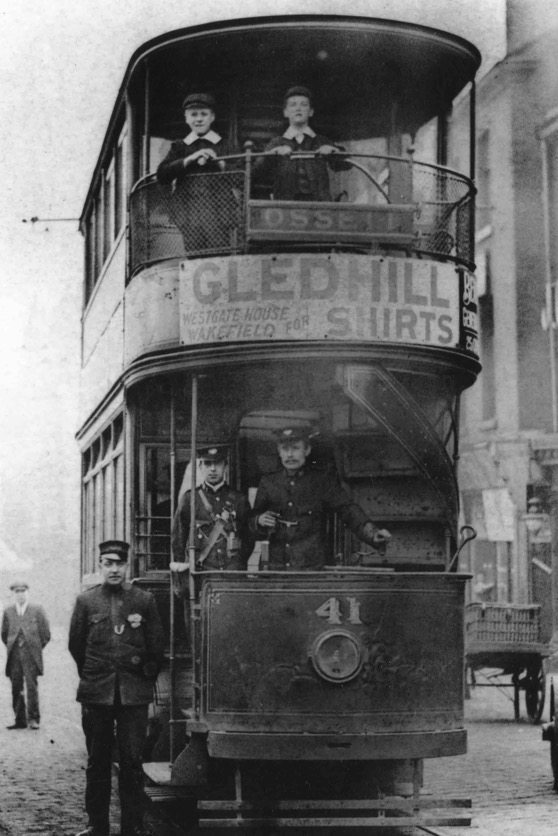
Tramcar No 41 stands at the Bull Ring in Wakefield in 1907, circa two years after the W&DLRCo was taken over by the Y(WR)ETCo. Author's Collection.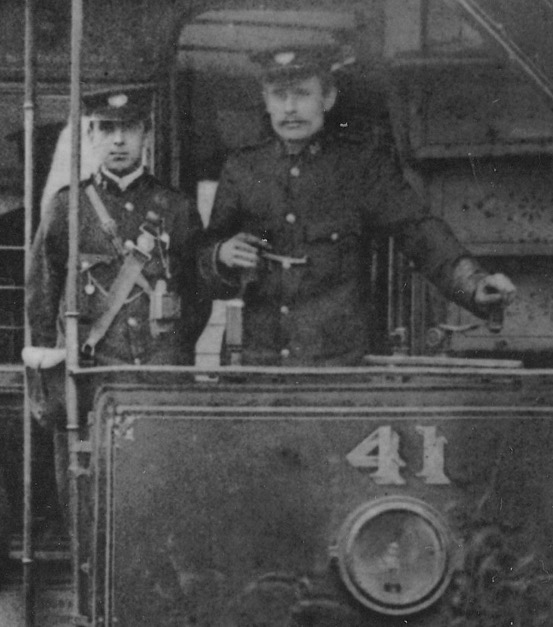
An enlargement of the above photograph showing the conductor and motorman. Although the men pictured may still be wearing W&DLR insignia, it is likely that new uniform issues bearing Y(WR) ETCo insignia had by this time replaced the older uniforms. Author's Collection.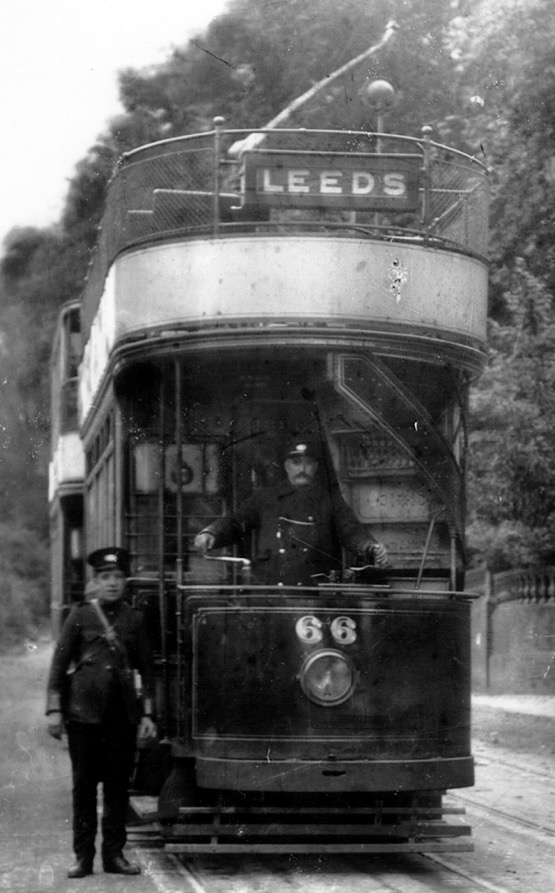
The crew of Tramcar No 66 pose for the cameraman at Sandal — photo undated, but probably taken in the late-Edwardian era, and certainly before 1912/13 when it was top covered. Photo courtesy of Wakefield Council (see link).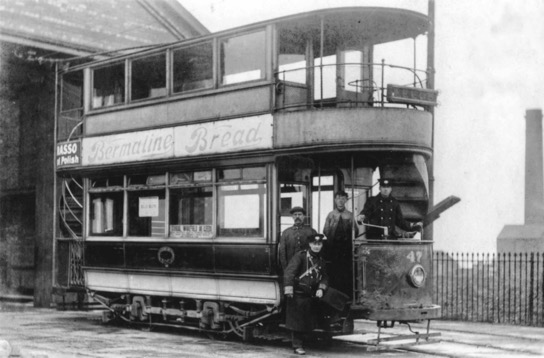
Tramcar No 47 stands with its crew and a couple of fitters in the depot yard at Sowood Lane depot, Ossett — photo dated 1910. Author's Collection.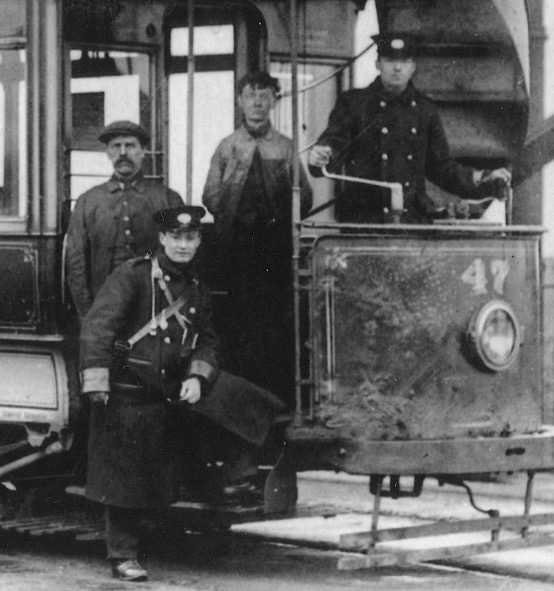
A blow-up of the above photo showing the conductor and motorman (apparently named 'Willie'), both in double-breasted greatcoats with epaulettes.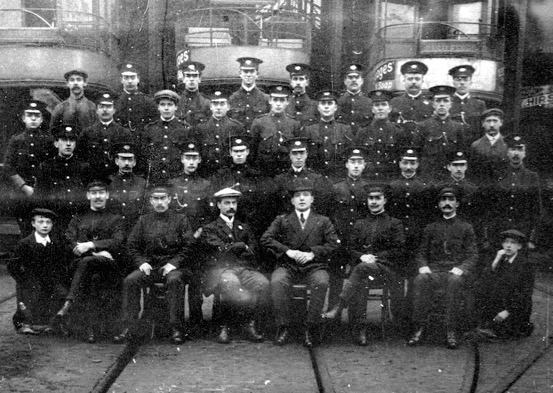
A staff photo taken at Wheldon Lane Depot, Castleford — photo undated, but believed to have been taken shortly before the Great War. Photo courtesy of Wakefield Council (see link).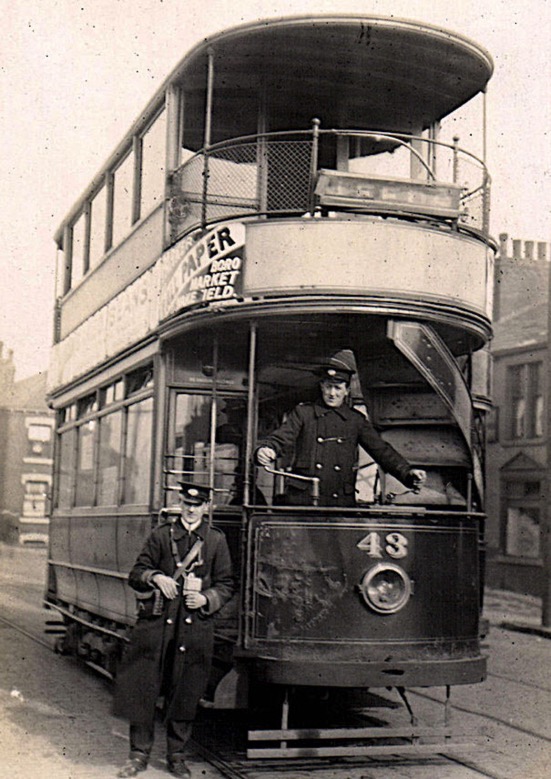
The crew of Tramcar No 43 stand with their rather battered charge on a service to Leeds — photo undated, but probably taken shortly after the Great War or the early 1920s. Source unknown.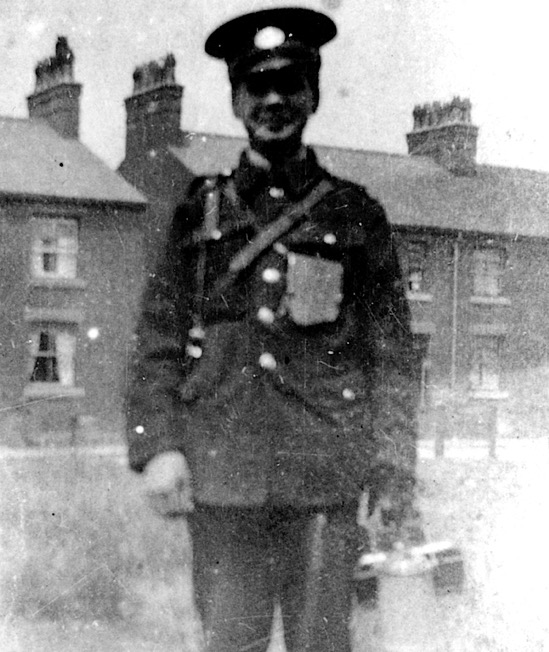
Conductor Edward Jay photographed in East Street, behind Pontefract Barracks, on his first day on the trams (aged 14 years) in 1921. The uniform is unchanged in style from that issued 15 years before. Photo courtesy of Wakefield Council (see link).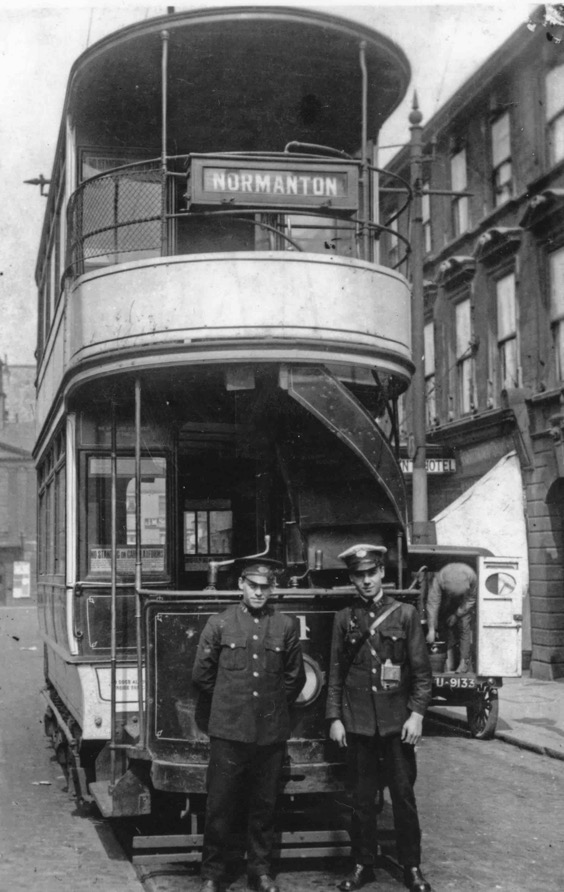
An unidentified tramcar, probably either No 11 or 21 stands with its crew at the terminus in Pontefract — photo undated, but probably taken not too long before the Castleford system closed in 1925. Author's Collection.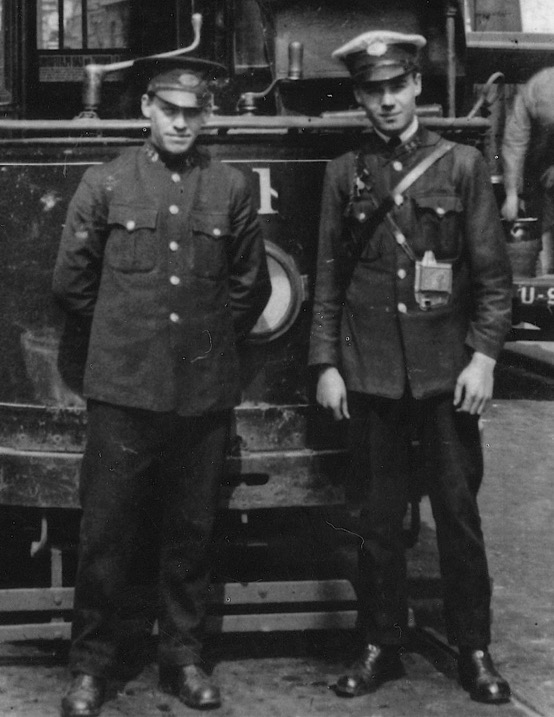
An enlargement of the above photograph showing the motorman and conductor, the latter with white rain cover on his cap indicating that it was summer. These late-period uniforms do not appear to have had epaulettes.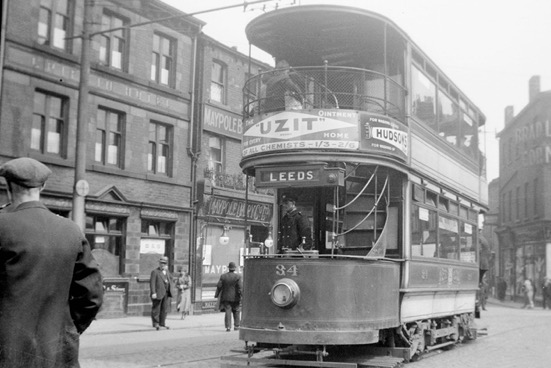
Y(WR)ETCo Tramcar No 34 captured at the Bull Ring, Wakefield, by the camera of M J O'Connor in 1932; the vehicle has the 'WEST RIDING' device on its waist panel, which was introduced in 1924. Photo courtesy of the National Tramway Museum. 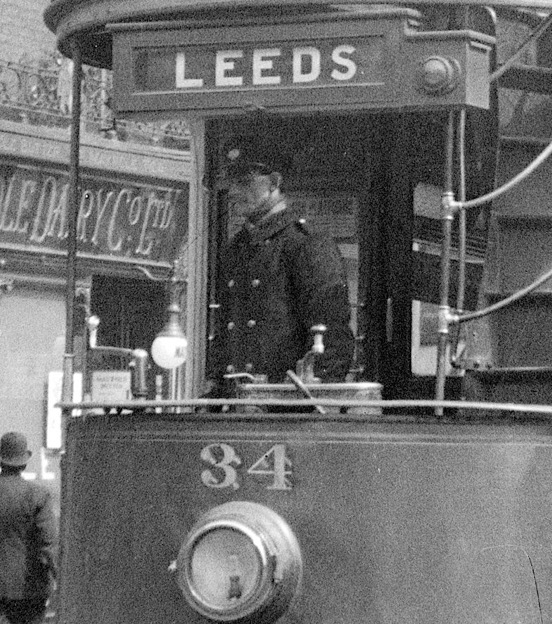
An enlargement of the above photo showing the motorman; he is clearly wearing the old oval style of cap badge rather than the new 'WEST RIDING' type (see below).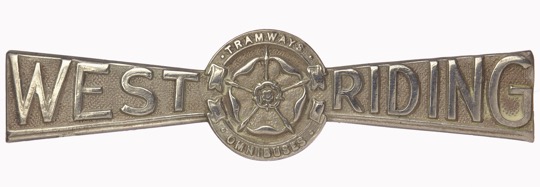
WEST RIDING TRAMWAYS & OMNIBUSES cap badge — nickel. Although this new device was introduced in 1924, the paucity of photographs showing staff wearing them, suggests that they were probably only issued to new tramway men or men who were working on the company's buses. Author's Collection.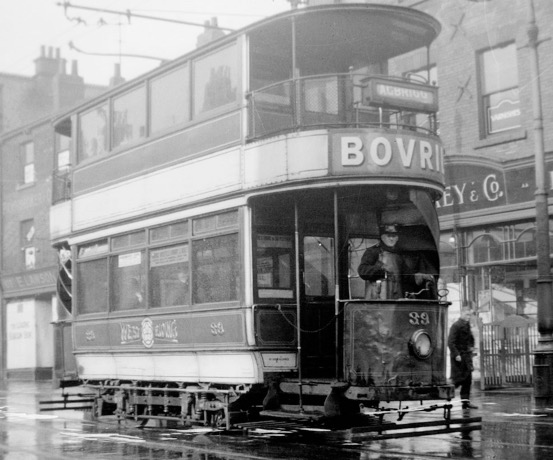
Another shot taken by M J O'Connor in 1932 in the Bull Ring, Wakefield, possibly on the same day as the shot of No 34 above. The rather incongruous 'WEST RIDING' device is easily made out on the tramcar's waist panel. Photo courtesy of the National Tramway Museum. 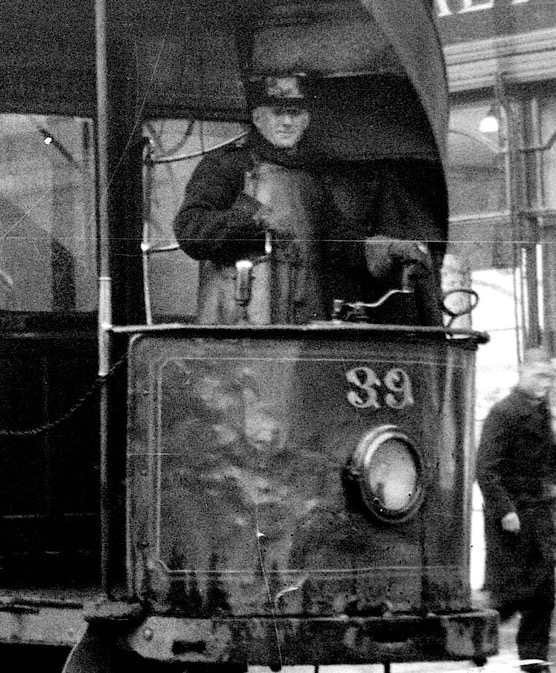
A blow-up of the above photo showing the motorman, in full-length leather apron.
Senior staff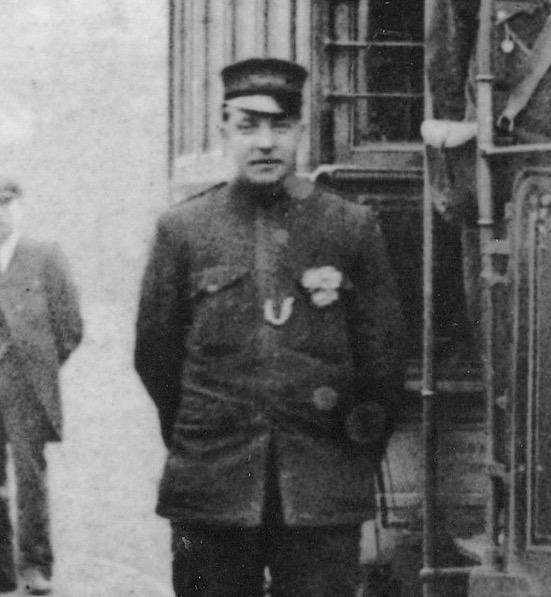
An enlargement of the photograph of Tramcar No 41 above — taken in 1907 — showing an inspector in drooping-peak cap.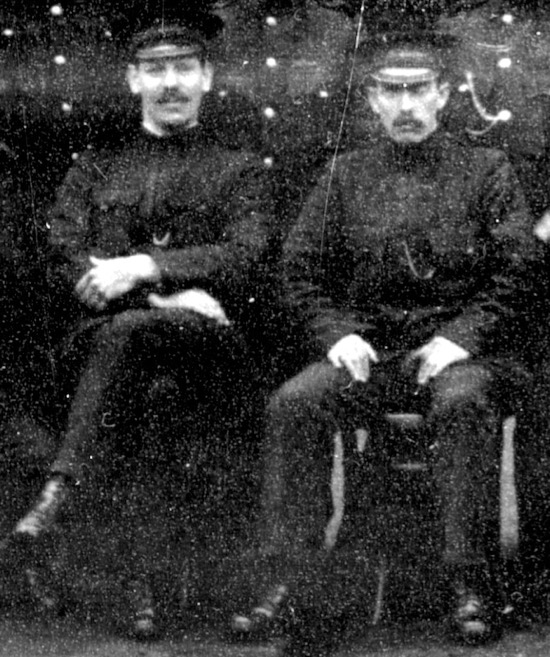
An enlargement of the Wheldon Rd depot photograph above showing two of the inspectors. By this time (circa 1912), the rather old-fashioned drooping-peak caps had been replaced with more modern tensioned-crown peaked caps. Photo courtesy of Wakefield Council (see link).
Female staff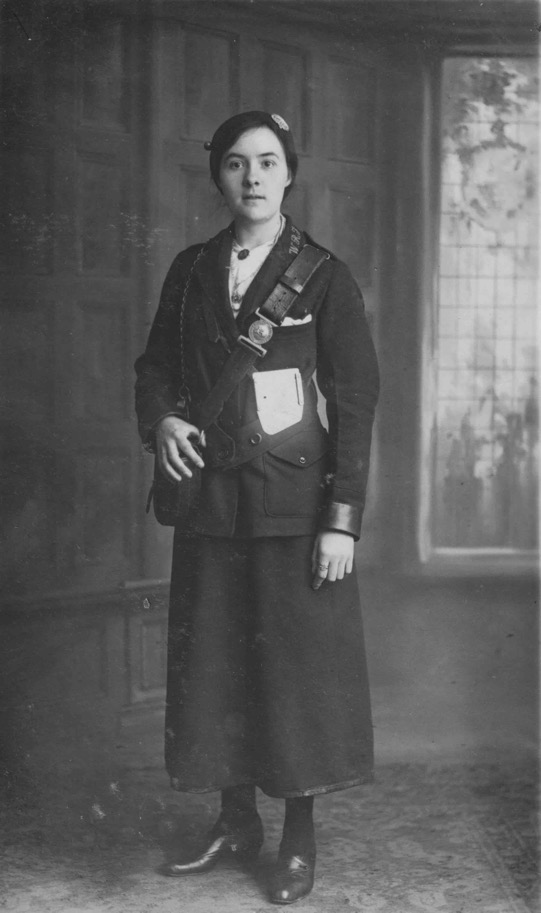
A superbly sharp studio portrait of a Great War Y(WR)ETCo conductress in her smart uniform. 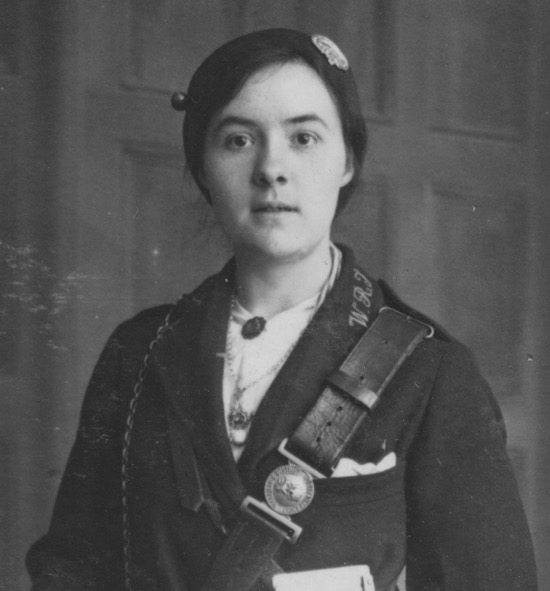
An enlargement of the above photograph showing details of the jacket and hat insignia. her brimless cloth bonnet bears the standard cap badge, her jacket collars embroidered script-lettering system initials, 'W R T'. Despite the Wakefield and District Light Railways Company have been taken over by the Yorkshire (West Riding) Electric Tramways Company in 1905, her cash-bag buckle bears the title of the former company.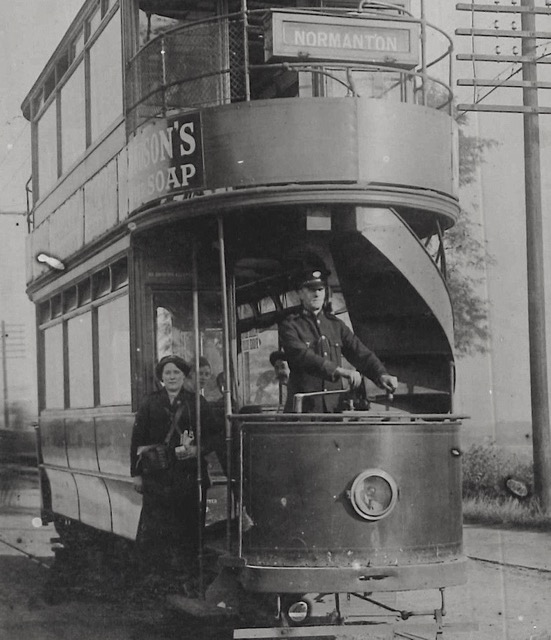
A rare photograph of a Y(WR)ETCo conductress on the platform of an unidentified tramcar bound for Normanton — photo undated, but almost certainly taken during the Great War. The conductress appears to be wearing a single-breasted jacket with lapels and epaulettes, along with a cloth bonnet; the latter possibly carrying the standard company cap badge.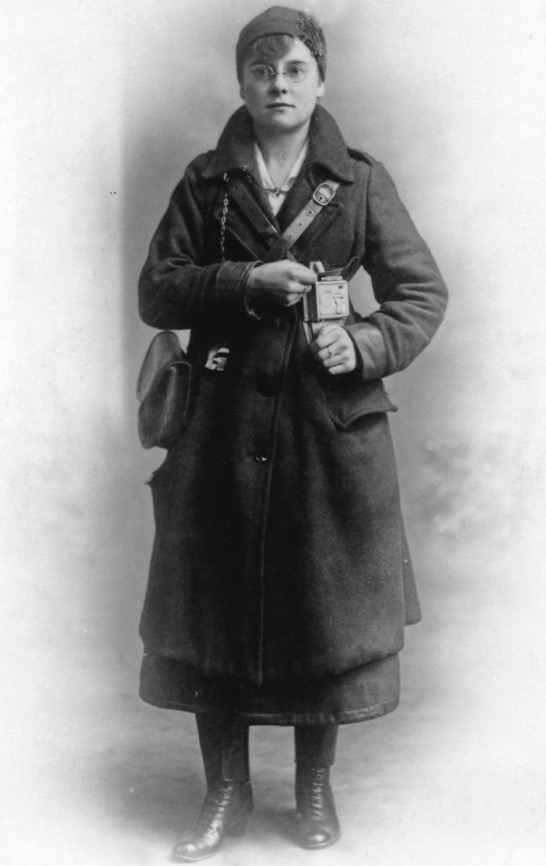
A portrait of a Great War tram conductress from a studio in Wakefield. Neither the coat nor the cloth bonnet bear insignia of any kind.